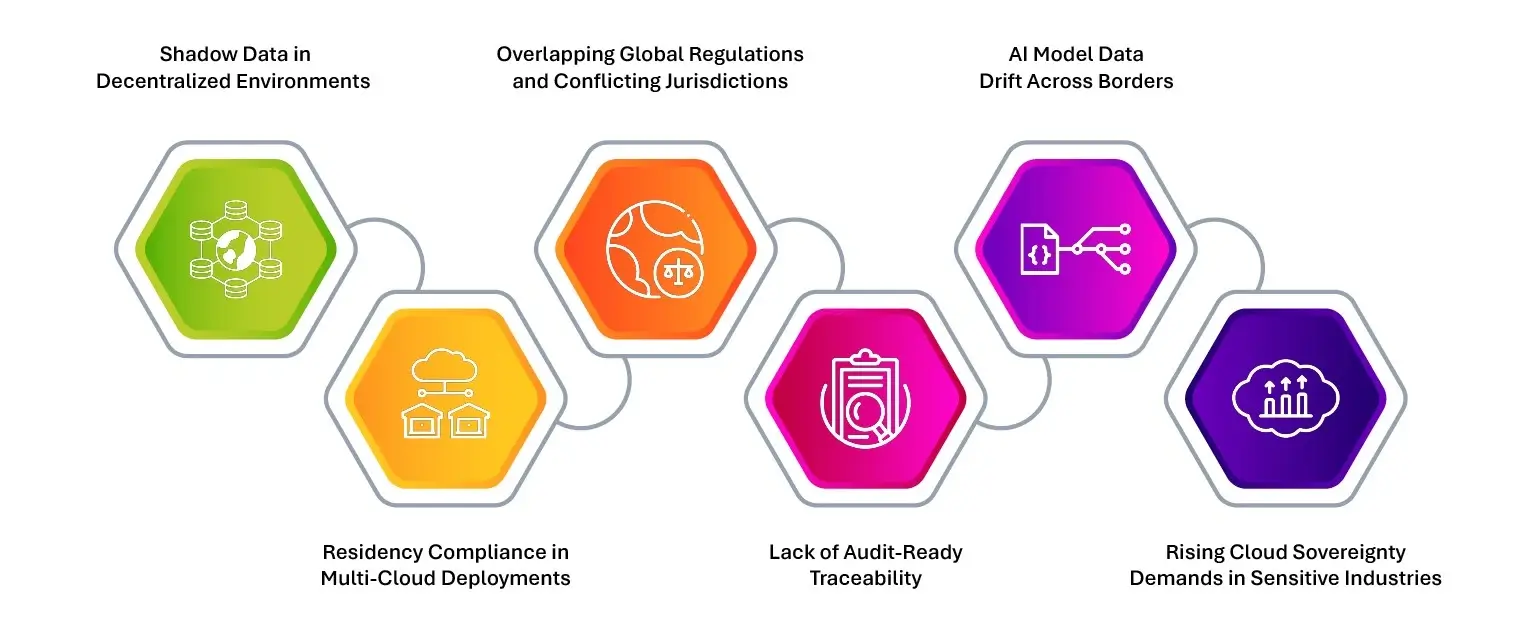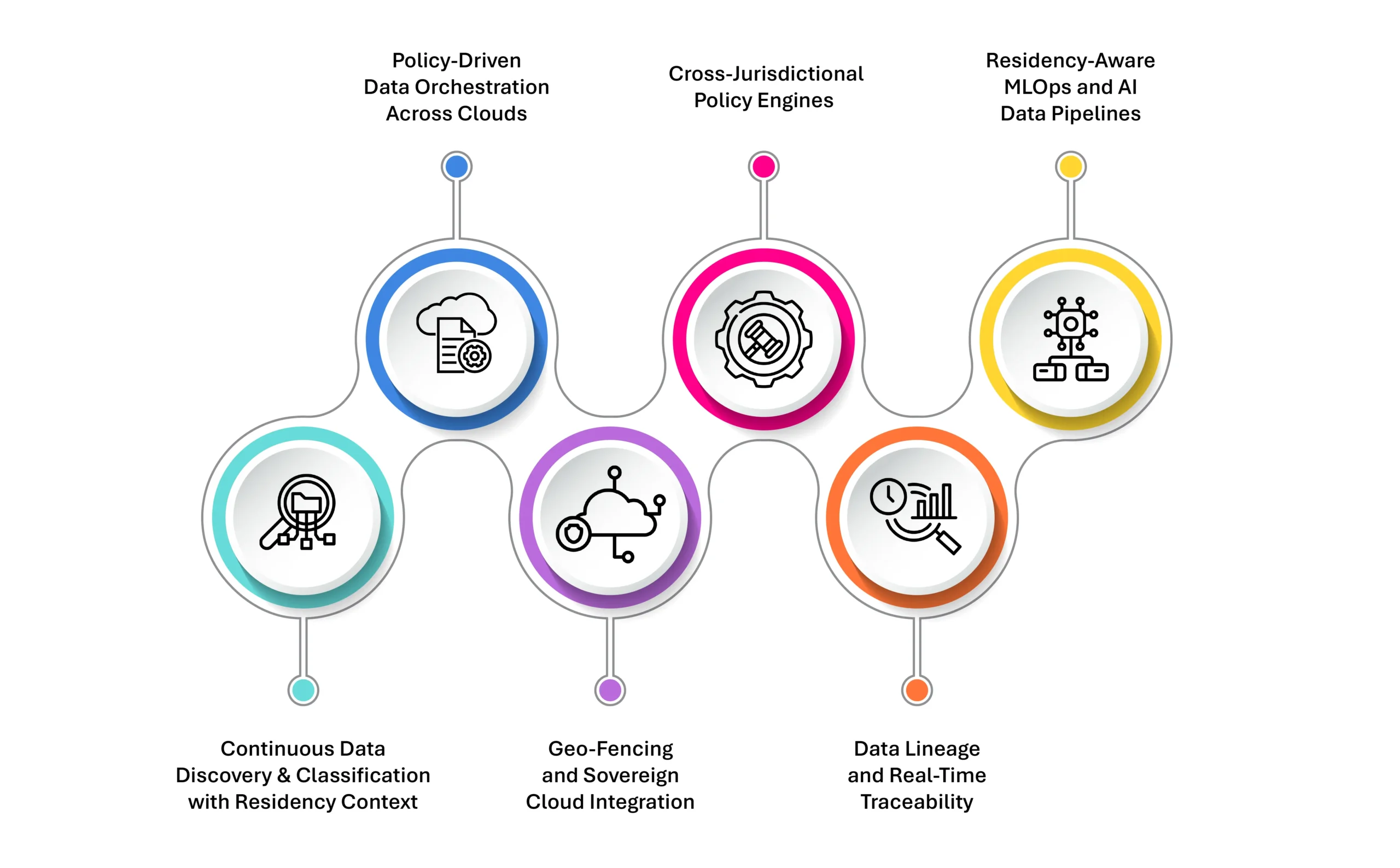What is Data Residency?
Data residency refers to the geographic location where data is stored and processed, often dictated by regulatory, operational, or legal requirements. Unlike data sovereignty, which emphasizes jurisdictional control, data residency focuses on the physical location of data and whether it aligns with national, sectoral, or contractual mandates.
For example, an enterprise may store customer data in India to comply with local privacy laws, even if the organization operates globally. In this context, data residency becomes a foundational element of trust, compliance, and infrastructure design.
Why Data Residency Matters Now More Than Ever
In 2025, as over 140 countries enforce some form of data localization or residency law, data residency is no longer an afterthought—it’s a strategic pillar of global business operations. Whether it’s GDPR in Europe, the DPDP Act in India, or the Cloud Computing Compliance Controls Catalog (C5) in Germany, governments are increasingly demanding that personal, financial, and critical infrastructure data stay within borders.
But it’s not just about legal mandates. For many enterprises, data residency also influences latency, performance, security posture, and customer trust. Cloud deployments must be architected with precision, not just for scale, but for compliance by design.
Challenges in Achieving Data Residency — And What to Do About Them

1. Shadow Data in Decentralized Environments
From collaboration tools to edge devices, data is being created and stored in unsanctioned locations beyond enterprise visibility or control.
2. Residency Compliance in Multi-Cloud Deployments
Running workloads across AWS, Azure, GCP, and private cloud makes it difficult to ensure that sensitive data remains within required jurisdictions.
3. Overlapping Global Regulations and Conflicting Jurisdictions
One dataset may fall under multiple legal frameworks (e.g., GDPR + CCPA), each with differing residency, access, and processing rules.
4. Lack of Audit-Ready Traceability
Most enterprises cannot demonstrate, on demand, where specific data was created, moved, stored, or processed across their lifecycle.
5. AI Model Data Drift Across Borders
Training datasets for AI applications are often copied, enriched, or shared across borders without visibility, violating residency mandates.
6. Rising Cloud Sovereignty Demands in Sensitive Industries
Governments and regulators are increasingly requiring that data and cloud infrastructure be sovereign—owned, operated, and supported locally.
Solving Data Residency Challenges: Strategic, Scalable, and Smart

Modern enterprises can no longer rely on manual policies or siloed cloud contracts to enforce data residency. What’s needed is a multi-layered strategy that combines intelligent automation, jurisdiction-aware governance, and architectural foresight.
Here’s how leading organizations are addressing data residency at scale:
1. Continuous Data Discovery & Classification with Residency Context
Deploy AI-driven discovery tools that don’t just find data, but understand it. By tagging datasets with geographic, regulatory, and sensitivity attributes, enterprises can make location-aware decisions across hybrid and multi-cloud landscapes.
✔ Enables automated enforcement of location-based controls
✔ Reduces the risk of accidental data sprawl
✔ Forms the basis for regulatory mapping and policy tuning
2. Policy-Driven Data Orchestration Across Clouds
Move beyond static cloud storage policies with dynamic data orchestration platforms that route, replicate, or restrict data based on evolving residency laws.
✔ Supports automated data placement, movement, and deletion
✔ Leverages metadata, region tags, and classification to enforce compliance
✔ Integrates with enterprise storage, cloud APIs, and compliance dashboards
3. Geo-Fencing and Sovereign Cloud Integration
Where legal requirements demand national hosting, integrate sovereign cloud environments or localized infrastructure partners that ensure operational control and local legal protection.
✔ Ensures physical residency and local jurisdictional control
✔ Meets sector-specific mandates (e.g., public sector, healthcare, finance)
✔ Builds digital trust with local customers and regulators
4. Cross-Jurisdictional Policy Engines
Replace ad-hoc compliance checklists with centralized governance platforms that interpret and apply laws across regions in real time—such as GDPR, CCPA, DPDP, and others.
✔ Enables unified global compliance with jurisdiction-specific flexibility
✔ Supports subject access request (SAR) management and audit readiness
✔ Reduces manual intervention and human error in enforcement
5. Data Lineage and Real-Time Traceability
Enable end-to-end visibility into data flows—tracking where data originated, how it’s transformed, and who accessed or moved it across borders.
✔ Essential for audits, incident response, and AI transparency
✔ Creates proof of compliance for residency, access, and retention
✔ Helps monitor AI pipelines for residency-aware training and inference
6. Residency-Aware MLOps and AI Data Pipelines
AI governance must begin with where and how training data is used. Modern MLOps pipelines now incorporate residency policies, ensuring models access only authorized and geographically compliant data.
✔ Prevents regulatory violations in AI use cases
✔ Supports explainability and ethical model development
✔ Aligns data governance with AI lifecycle management
Geo-Intelligent Data: Why Residency is the New Digital Infrastructure
In an era where data fuels economies, powers AI, and determines national competitiveness, data residency is no longer just a compliance issue—it’s digital infrastructure by design.
As AI models increasingly rely on localized datasets to deliver context-aware, culturally sensitive, and regulation-compliant outcomes, residency isn’t just about “where” data is stored—it’s about how data is governed, protected, and trusted at the point of origin. AI trained on data that violates residency mandates not only risks regulatory backlash but also loses credibility in the eyes of consumers and regulators.
In high-stakes industries like healthcare, finance, defense, and energy, data residency directly impacts national resilience. It ensures that sensitive data is processed within trusted jurisdictions, reducing exposure to foreign surveillance, legal overreach, or cross-border conflict. For countries investing in sovereign cloud ecosystems, residency is the blueprint for digital self-determination.
Meanwhile, for global enterprises navigating overlapping privacy regimes—GDPR, DPDP, CCPA, and more—data residency becomes a strategic lever to simplify governance, automate compliance, and enable regional innovation at scale.
In this new landscape, leaders aren’t asking, “Where is our data stored?”—they’re asking, “Can we prove it, govern it, and optimize it—locally and lawfully?”
The organizations that are architected with data residency in mind are not only building for today’s regulatory landscape—they’re future-proofing their operations, AI models, and brand trust in a world where digital borders matter as much as physical ones.
Getting Started with Data Dynamics:
- Learn about Unstructured Data Management
- Schedule a demo with our team
- Read the latest blog: Sovereign AI and the Future of Nations: Why Data, Infrastructure, and Intelligence Must Align






